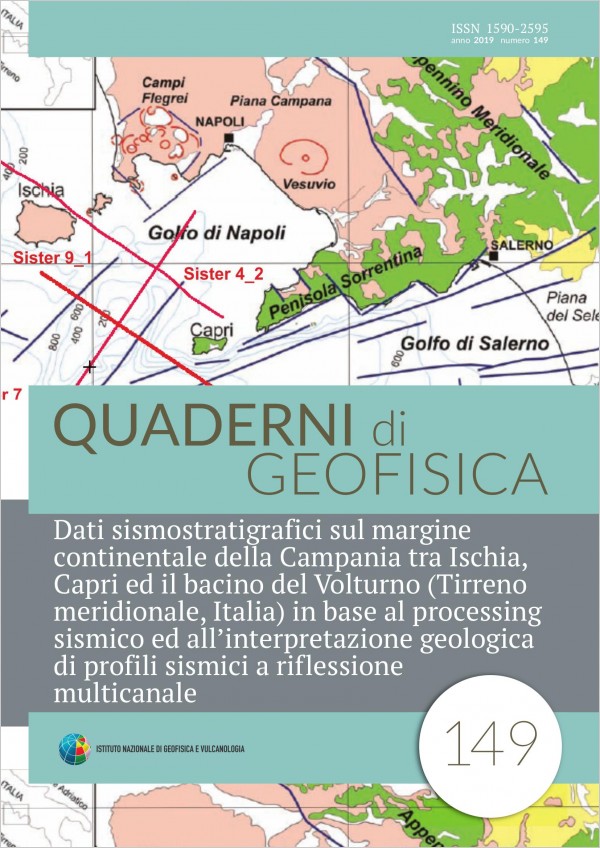Dati sismostratigrafici sul margine continentale della Campania tra Ischia, Capri ed il bacino del Volturno (Tirreno meridionale, Italia) in base al processing sismico ed all’interpretazione geologica di profili sismici a riflessione multicanale
Main Article Content
Abstract
Deep multichannel profiles located on the Campania continental margin have been processed and interpreted with the aim to highlight new evidence on the tectono-stratigraphic setting of this sector of Southern Italy Tyrrhenian margin. In particular, the interpreted seismic profiles have crossed the geological structures of the Ischia and Capri Islands and the Volturno offshore. The regional geological structure of the Campania continental margin is characterized by several geological structures and corresponding seismic units, both volcanic and sedimentary in nature. The interpreted seismic sections have been divided in different sectors due to their different reflectivity, respectively good next to the Sorrento Peninsula and to the Volturno river mouth and low next to the Magnaghi canyon and the Ischia structural high due to volcanic and volcaniclastic layers. The continental slope of Capri Island-Bocca Piccola is distinguished from the occurrence of a carbonate structure controlled by the related deep carbonatic seismic unit, overlain by thick sedimentary seismic units, represented by relict prograding wedges, probably Middle-Late Pleistocene in age. These units, are, in turn, overlain by a thin Holocene drape, suggesting a starvation on the continental slope off Bocca Piccola during the Late Quaternary, when this area was a structural high, characterized by Meso- Cenozoic carbonates northwestwards dipping and representing the seawards prolongation of the Capri structural high. Acoustically-transparent seismic facies have been observed in the Magnaghi canyon- Ischia offshore sector, located in correspondence to the volcanic Ischia structural high. Seismic interpretation has shown that the incision of the Magnaghi canyon, characterized by a depth of maximum cut of 450 m, has mainly involved the volcanic deposits, lacking of internal reflectivity. Another main sector is represented by the Volturno basin, where three seismic units have been identified, representing the basin filling. They have been respectively interpreted as Pleistocene coastal shales alternating with volcaniclastic deposits, as Middle Pleistocene deltaic and marine deposits and as Miocene flysch deposits, genetically related with the Frosinone Flysch. The Magnaghi basin, herein recognized and previously unknown, is a small basin located in the Ischia offshore, whose infilling is characterized by parallel and continuous seismic reflectors. A morpho-structural high (“Banco di Fuori” or “Banco di Bocca Grande”), bounding southwards the Naples Bay and high about 800 m, is characterized by the occurrence of the deep carbonate seismic unit, representing its stratigraphic bulk. While its north-western flank is characterized by the occurrence of thick relict prograding wedges, the south-eastern one is downthrown by the Acerra-Dohrn canyon normal fault, one of the most significant counter-Apenninic (NE-SW) trending regional faults controlling the structure of the Naples Bay. The high is laterally bounded by the Dohrn canyon in its southern part and by the Magnaghi canyon in its northern part. The Capri structural high is characterized by marked reflectors, parallel and continuous, interpreted as the upper relict prograding wedge (B unit), overlying the lower relict prograding wedge (A unit). Both the wedges unconformably overlie the deep carbonate unit. The passage to the Salerno Valley happens through the Capri-Sorrento regional normal fault, NNW-SSE trending, characterized by a throw of about 1 km and active during the Pleistocene. This fault separates the Salerno Bay from the Naples Bay. The Salerno Valley is filled by four seismic units. The most recent one is characterized by continuous and parallel seismic reflectors and has been put in relationships with Quaternary marine and continental deposits, overlying Pleistocene deposits, showing the same seismic characteristics and representing the second seismic unit. The third unit shows discontinuous reflectors interpreted as Miocene flysch deposits, genetically related with the Cilento Flysch, while the deepest one has been interpreted as Mesozoic carbonate deposits.
Article Details
Section
Article

This work is licensed under a Creative Commons Attribution 4.0 International License.

